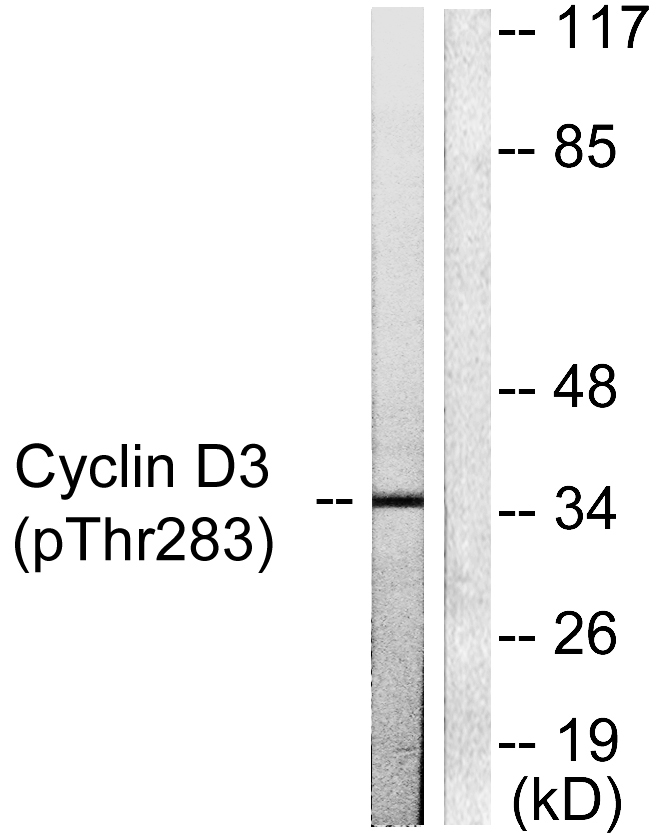Cyclin D3 (phospho Thr283) Polyclonal Antibody
- Catalog No.:YP0080
- Applications:WB;IHC;IF;ELISA
- Reactivity:Human;Mouse;Rat
- Target:
- Cyclin D3
- Fields:
- >>Cell cycle;>>p53 signaling pathway;>>PI3K-Akt signaling pathway;>>Cellular senescence;>>Wnt signaling pathway;>>Hippo signaling pathway;>>Focal adhesion;>>JAK-STAT signaling pathway;>>Measles;>>Influenza A;>>Human papillomavirus infection;>>Human T-cell leukemia virus 1 infection;>>Epstein-Barr virus infection;>>Pathways in cancer;>>Viral carcinogenesis;>>Chemical carcinogenesis - receptor activation
- Gene Name:
- CCND3
- Protein Name:
- G1/S-specific cyclin-D3
- Human Gene Id:
- 896
- Human Swiss Prot No:
- P30281
- Mouse Gene Id:
- 12445
- Mouse Swiss Prot No:
- P30282
- Rat Gene Id:
- 25193
- Rat Swiss Prot No:
- P48961
- Immunogen:
- The antiserum was produced against synthesized peptide derived from human Cyclin D3 around the phosphorylation site of Thr283. AA range:243-292
- Specificity:
- Phospho-Cyclin D3 (T283) Polyclonal Antibody detects endogenous levels of Cyclin D3 protein only when phosphorylated at T283.
- Formulation:
- Liquid in PBS containing 50% glycerol, 0.5% BSA and 0.02% sodium azide.
- Source:
- Polyclonal, Rabbit,IgG
- Dilution:
- WB 1:500 - 1:2000. IHC 1:100 - 1:300. ELISA: 1:5000.. IF 1:50-200
- Purification:
- The antibody was affinity-purified from rabbit antiserum by affinity-chromatography using epitope-specific immunogen.
- Concentration:
- 1 mg/ml
- Storage Stability:
- -15°C to -25°C/1 year(Do not lower than -25°C)
- Other Name:
- CCND3;G1/S-specific cyclin-D3
- Observed Band(KD):
- 32kD
- Background:
- The protein encoded by this gene belongs to the highly conserved cyclin family, whose members are characterized by a dramatic periodicity in protein abundance through the cell cycle. Cyclins function as regulators of CDK kinases. Different cyclins exhibit distinct expression and degradation patterns which contribute to the temporal coordination of each mitotic event. This cyclin forms a complex with and functions as a regulatory subunit of CDK4 or CDK6, whose activtiy is required for cell cycle G1/S transition. This protein has been shown to interact with and be involved in the phosphorylation of tumor suppressor protein Rb. The CDK4 activity associated with this cyclin was reported to be necessary for cell cycle progression through G2 phase into mitosis after UV radiation. Several transcript variants encoding different isoforms have been found for this gene. [provided by RefSeq, Oct 2008],
- Function:
- function:Essential for the control of the cell cycle at the G1/S (start) transition. Potentiates the transcriptional activity of ATF5.,similarity:Belongs to the cyclin family.,similarity:Belongs to the cyclin family. Cyclin D subfamily.,subunit:Interacts with the CDK4 and CDK6 protein kinases to form a serine/threonine kinase holoenzyme complex. The cyclin subunit imparts substrate specificity to the complex. Interacts with ATF5. Interacts with EIF3K.,
- Subcellular Location:
- Nucleus . Cytoplasm .
- Expression:
- Brain,Lung,Placenta,Synovial membrane tissue,Umbilical cord blood,
- June 19-2018
- WESTERN IMMUNOBLOTTING PROTOCOL
- June 19-2018
- IMMUNOHISTOCHEMISTRY-PARAFFIN PROTOCOL
- June 19-2018
- IMMUNOFLUORESCENCE PROTOCOL
- September 08-2020
- FLOW-CYTOMEYRT-PROTOCOL
- May 20-2022
- Cell-Based ELISA│解您多样本WB检测之困扰
- July 13-2018
- CELL-BASED-ELISA-PROTOCOL-FOR-ACETYL-PROTEIN
- July 13-2018
- CELL-BASED-ELISA-PROTOCOL-FOR-PHOSPHO-PROTEIN
- July 13-2018
- Antibody-FAQs
- Products Images

- Immunohistochemistry analysis of paraffin-embedded human lung carcinoma, using Cyclin D3 (Phospho-Thr283) Antibody. The picture on the right is blocked with the phospho peptide.

- Western blot analysis of lysates from K562 cells treated with UV 5', using Cyclin D3 (Phospho-Thr283) Antibody. The lane on the right is blocked with the phospho peptide.



